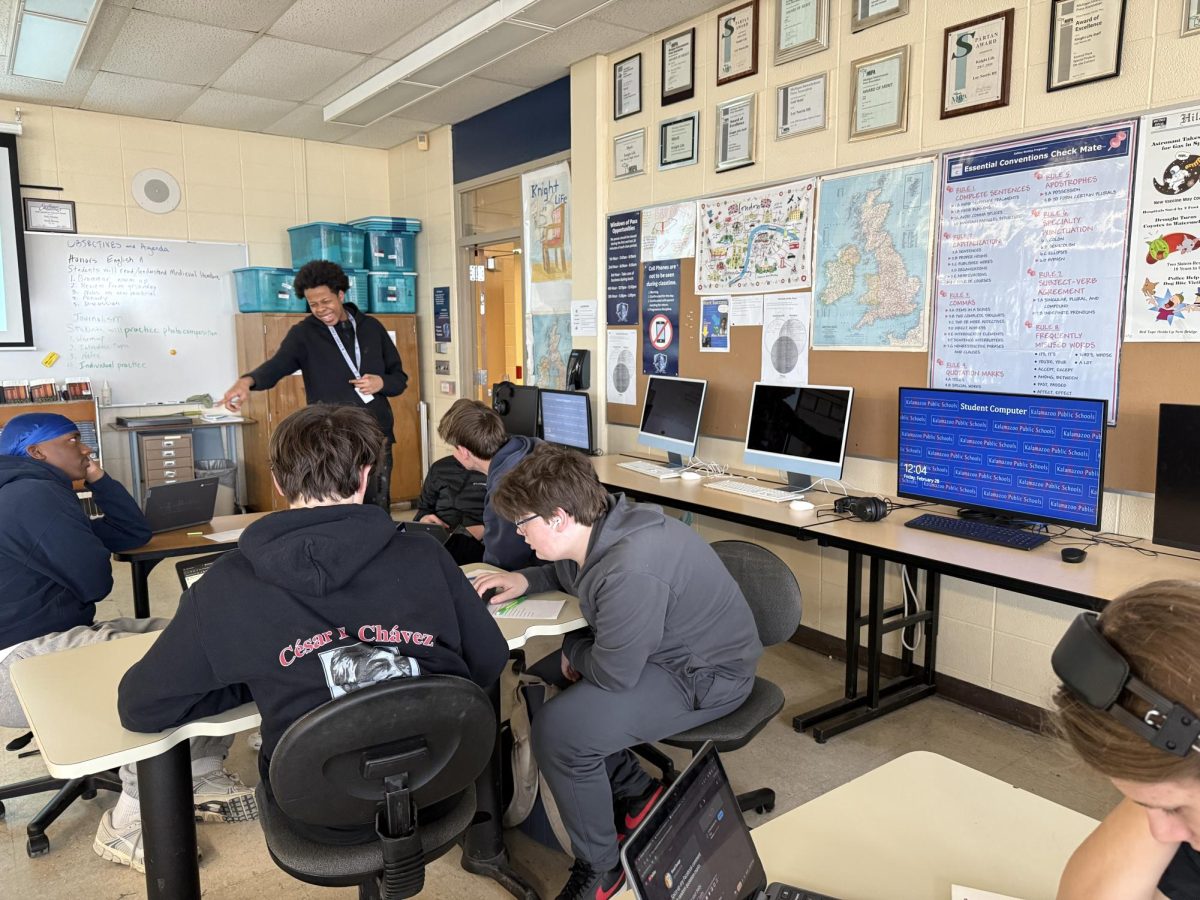By Emma Fergusson, Guest Writer

“You know, no one has time to just go out in the woods for a few hours,” said senior Bethany Dunham.
Like many of her fellow Loy Norrix students, Dunham dreams of a world in which she could forget about the books and papers that weigh down her backpack, and focus more on the little pleasures in life, like just taking a walk through the woods. While attending high school, however, many teenagers find themselves so preoccupied with schoolwork that they must sacrifice their personal lives.
“There’s never enough time. Twenty-four hours in a day is not enough,” said Dunham.
It seems that Dunham’s creed rings true for many of her peers. Psychology teacher Rebecca Layton said that the biggest complaint she hears from her students is that they do not have enough time to complete all that is expected of them.
“[Students complain about] lack of time and expectations from themselves and everybody else,” Layton said.
This kind of pressure can build up over the course of a student’s time in high school and ultimately impact them in negative ways. When a busy schedule becomes an all-consuming aspect of a person’s life, she often fails to remember to put her own well-being first.
“I think by the time we get older, there’s just a lot of pressure that they [students] put on themselves, and, also, it’s a lot of not taking very good care of themselves,” Layton said. “They don’t take the time to sleep or they don’t eat properly or they’re trying to do everything and not taking care of themselves.”
One of the major culprits contributing to this stress is the homework load students face on a weekly basis. According to a 2014 study done by University of Phoenix College of Education, teachers in the United States reported assigning ninth through twelfth grade students an average of 3.5 hours of homework each week. With five different teachers in a schedule, this could amount to 17.5 hours of homework every week for high school students.
With faster paced learning opportunities provided through Advanced Placement (AP) classes, as well as through programs like the Kalamazoo Area Mathematics and Science Center (KAMSC) and the Academically Talented Youth Program (ATYP), Loy Norrix students may spend even more time studying outside of school.
Freshman Raili Nelson participates in both KAMSC and ATYP. Additionally, Nelson swims, and when practices run well into the evenings, time for completing school work becomes limited.
“[One time] I forgot that I had four pages of Cornell Notes I had to do on a biology chapter, and I still had to do my journal, and I had to do a paper, and I was up until one in the morning,” said Nelson.
While students like Nelson prove that it is possible to keep up with the piles of homework distributed daily, the endless stream of notes to take and vocabulary to learn does become tiresome. Even to the most diligent of students, the homework load seems excessive.
“A lot of times the problem is that I get a lot [of homework] at once, and it’s not spread out like it should be,” said Dunham, “so when I get a lot at once from multiple teachers it’s very overwhelming.”
With an ever increasing emphasis on attending college after high school, particularly in Kalamazoo Public Schools, and rising rates of selectivity at top universities, it seems that students have good reason for feeling such intense pressure to succeed.
According to “U.S. News,” in 1990, the Ivy League school University of Pennsylvania had an acceptance rate of 41 percent. In 2017, that rate has dropped to 10 percent. Even large, public universities like University of Michigan only accept 26.2 percent of their applicants.
With these facts looming over their heads, students proceed through high school, pushing themselves to do more, and consequently finding less time to do the things they care about.
“I don’t want to spend all my time locked in my room doing homework . . .” said Dunham. “I only get to say ‘hi’ to my family when I walk out the door and go to work.”
It seems that freshmen, seniors and all students in between must face the constraints of the clock and the stress of the homework load, but the pressures of school are not the only forces at work. For students like Bethany Dunham, school life is tightly sandwiched between an unreliable work schedule and time-consuming extracurricular activities.
“Well, of course I go to school,” said Dunham, “then I go home and I either go to work for a few hours, or I do my homework and then I go to work. Sometimes I do homework before and after work. It kind of depends on my work schedule, which is different every week.”
With so much responsibility to keep up with, it becomes difficult to pursue personal interests or even to spend time with loved ones.
“I wish I could spend more time with my family and friends,” said Dunham.
“I’d like to draw more because I really like drawing, but I haven’t gotten to do that in a while,” said Nelson. “I think I would read more of what I like to read [if I had more time] and just take time just to sit.”
With such busy lives, students often miss out on simply enjoying themselves and taking in the high school experience. Additionally, they may struggle to handle all that is expected of them. Coping properly with an overwhelming schedule and managing time well could be imperative to balancing school and personal lives, and to keeping stress at bay.
“If you let it [homework] sit there and don’t think about when you’re going to get it done, it can sneak up on you and like, freak you out,” said Nelson.
According to Layton, while keeping up with school work, juggling other activities and responsibilities and starting down the right path for the future is important, it is absolutely vital to take care of yourself by maintaining healthy relationships, not overwhelming yourself and taking breaks when needed.
“The recommendation I always give,” said Layton, “is . . . you can’t pour from an empty cup. So if you’re not taking care of yourself, you can’t do the other things. So, take [a] half-hour, color, read a book, go for a walk, put your phone down, . . . do something where you get to be really in that moment. So when you come back to all the other stuff you’re going to do, you’re ready to do it.”
In a survey published by the American Psychological Association, teens reported an average stress level of 5.8 on a 10 point scale. Dunham reported, without hesitation, a stress level of 7 on a 10 point scale.
Sometimes, just taking a step back from everything can make all the difference. In order to handle all of her commitments and rigorous school work, Dunham makes an effort to put her priorities in order and to never push herself too far.
“I deal with it by just making sure I get little things that can help, like sleep. I try not to stay up too late doing homework,” said Dunham. “I also make sure that I still have time for personal stuff because I think that’s really important. And for everyone I think it’s just important that sometimes you do have to put your personal life above your school life because you know you’re only in school for so long, but your personal life keeps going.”
For students who struggle to find a healthy balance in their high school lives, Layton puts things in perspective.
“You are in high school, these are not the best years of your life,” said Layton. “However, this is really your time to learn to take good care of yourself. Doing everything isn’t important, and doing nothing is not a viable alternative.”







